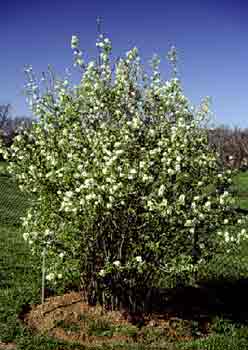 Shadblow Serviceberry - Amelanchier canadensis
Shadblow Serviceberry - Amelanchier canadensis
Rose Family (Rosaceae)
Introduction: Shadblow serviceberry is a dense multistemmed shrub or small tree that can reach 20 feet tall. It offers showy white flowers in spring, and is the most winter hardy of the serviceberries.
Culture: Shadblow serviceberry should be grown in full sun or light shade. It prefers moist, well-drained, acidic soil. Shadblow serviceberry needs pruning only if multiple stems are being thinned to enhance the appearance of the trunk. This tree rarely needs to be fertilized. It is hardy in Zones 3 to 7 (possibly 8). Shadblow serviceberry is resistant to pests. It is prone to fire blight.
Botanical Information
 Native habitat: Eastern North America in wet bogs and swamps.
Native habitat: Eastern North America in wet bogs and swamps.- Growth habit: Upright, multistemmed large shrub to small tree.
- Tree size: Height ranges from 6 to 20 feet.
- Flower and fruit: White flowers are borne in erect 2- to 3-inch-long racemes in early spring. Flowers about one week after A. arborea. Fruit is round, less than ½ -inch in diameter. Fruit is purple to red, sweet and attracts wildlife.
- Leaf: Leaves are alternate, simple, 1½ to 2½ inches long and ½ to 11/4 inches wide. Leaves are finely toothed. They are medium to dark green in summer. Fall color ranges from yellow and gold to orange and red.
- Hardiness: Winter hardy to USDA Zone 3.
‘Prince William' - Has small white flowers in clusters, and edible purplish blue fruit. Fall color is orange to red. This plant fruits very heavily.
Additional information:
Shadblow serviceberry got its common name because it fruits in June "when the shad (a northern fish) run." All the serviceberries make good small landscape trees or multistemmed shrubs. Serviceberry is a common understory tree in southeastern forests of North America. The wood of serviceberry is among the heaviest in the U.S., and would be more valuable if the trees grew larger. Shadblow serviceberry flowers about one week later than A. arborea, downy serviceberry. Serviceberry's fruit is used to make pies and sweetbreads and can be dried like raisins. Cherokees used serviceberry tea to aid digestion, and children who had worms were given baths in serviceberry tea. Native Americans used the tree's straight wood to make arrow shafts. Francois Michaux wrote of serviceberries being available in Philadelphia markets, but only children bought them. Serviceberries have good fall color and the bark is grayish and ornamental. It becomes ridged and furrowed as the tree ages. Shadblow serviceberry is an excellent choice for a naturalized garden, where it can spread naturally by suckering. It also makes an attractive specimen plant or can be used in front of an evergreen background.
Shadblow serviceberry got its common name because it fruits in June "when the shad (a northern fish) run." All the serviceberries make good small landscape trees or multistemmed shrubs. Serviceberry is a common understory tree in southeastern forests of North America. The wood of serviceberry is among the heaviest in the U.S., and would be more valuable if the trees grew larger. Shadblow serviceberry flowers about one week later than A. arborea, downy serviceberry. Serviceberry's fruit is used to make pies and sweetbreads and can be dried like raisins. Cherokees used serviceberry tea to aid digestion, and children who had worms were given baths in serviceberry tea. Native Americans used the tree's straight wood to make arrow shafts. Francois Michaux wrote of serviceberries being available in Philadelphia markets, but only children bought them. Serviceberries have good fall color and the bark is grayish and ornamental. It becomes ridged and furrowed as the tree ages. Shadblow serviceberry is an excellent choice for a naturalized garden, where it can spread naturally by suckering. It also makes an attractive specimen plant or can be used in front of an evergreen background.


